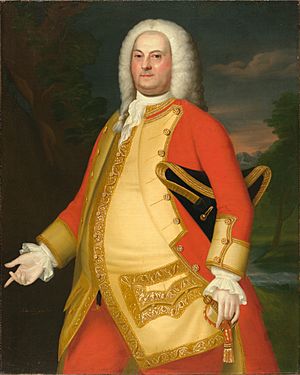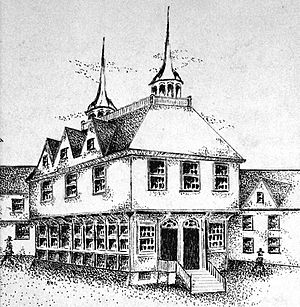William Brattle facts for kids
Quick facts for kids
William Brattle
|
|
|---|---|
 |
|
| Massachusetts Attorney General | |
| In office 1736–1738 |
|
| Monarch | George II |
| Preceded by | John Overing |
| Succeeded by | Edmund Trowbridge |
| Personal details | |
| Born | April 18, 1706 Cambridge, Massachusetts |
| Died | October 25, 1776 (aged 70) Halifax, Nova Scotia |
| Spouses | Katherine Saltonstall (m. 1727) Martha Fitch (m. 1752) |
| Children | 9, including Thomas and Katherine |
| Military service | |
| Allegiance | (1729–1776) |
| Branch/service | (1729–1776) |
| Rank | Major-General |
| Unit | 1st Regiment of Militia of Middlesex |
| Battles/wars | King George's War French and Indian War |
Major-General William Brattle (born April 18, 1706 – died October 25, 1776) was an important person in early American history. He was a politician, lawyer, doctor, and military officer. He even served as the Attorney General of Massachusetts from 1736 to 1738.
Brattle is most remembered for his role during the American Revolution. At first, he supported the Patriot cause, which wanted independence from Britain. But later, he changed his mind and joined the Loyalist camp, who wanted to stay loyal to the British king. This change led to big problems for him.
William Brattle came from a rich and well-known family in Massachusetts. He went to Harvard College and graduated in 1722. After college, he became one of the wealthiest people in Massachusetts. He worked as a doctor and lawyer, but spent most of his career as a politician and military officer. He served in the colonial militia during two French and Indian Wars. By 1760, he had become a brigadier-general.
As tensions grew between Great Britain and its American colonies, Brattle first sided with the Patriots. However, he switched to the Loyalists after a disagreement about judges' salaries. In 1774, Brattle wrote a letter to Governor Thomas Gage about a gunpowder storage building near Boston. This led Gage to move the gunpowder, which made local people very angry. Brattle then had to seek protection from the British.
Brattle stayed in British-controlled Boston when the American Revolutionary War began. He was there during the Siege of Boston in 1776. When the British Army left Boston in March 1776, Brattle went with them. He settled in Halifax, Nova Scotia, where he died seven months later at age 70. Today, Brattle Street in Cambridge and the town of Brattleboro, Vermont, are named after him.
Contents
Early Life and Education
William Brattle was born on April 18, 1706, in Cambridge, Massachusetts. His father, also named William Brattle, was a Congregational minister. He served as a minister in Cambridge from 1696 to 1717. Brattle's father also graduated from Harvard College and was a member of the Royal Society. He also owned enslaved people. William's mother was Elizabeth Hayman Brattle, who passed away in 1715.
After his father died in 1717, young William started attending Harvard College. He was a very good student and entered at the top of his class. His classmates included Richard Saltonstall and William Ellery Sr.. Brattle graduated from Harvard in 1722 with a Bachelor of Arts degree.
In 1727, when he was 21, Brattle inherited a lot of money and property. He was the only heir to his father's and his uncle Thomas's estates. This made him one of the richest men in all of Massachusetts. He had enough money to follow his interests. In the same year, he had a large mansion built for himself.
Career in Massachusetts
After graduating from Harvard, Brattle briefly worked as a minister. But by 1725, he decided he didn't want to be a minister anymore. He then started practicing medicine, helping people in Cambridge, including college students. He also had his own law practice. Brattle was very dedicated to Harvard and served on the Harvard Board of Overseers.
In 1729, Brattle became a selectman in Cambridge. Selectmen were leaders in the town's local government. He served as a selectman 21 times during his life. In 1736, he was elected as a representative to the House of Assembly of Massachusetts Bay. In the same year, Brattle also became the Massachusetts Attorney General. He held this important job until 1738.
Because of his family, Brattle was part of the important people in Massachusetts. He became involved in major political, religious, and military events. In the 1740s, he disagreed with the First Great Awakening. This was a big Christian religious movement in Britain and its American colonies. Brattle argued publicly with George Whitefield, a leader of the movement.
In 1729, Brattle began his military career in the Massachusetts Militia. He joined the Ancient and Honorable Artillery Company of Massachusetts (AHAC). Five years later, in 1733, he was an officer in the 1st Regiment of Militia of Middlesex. Brattle wrote a military guide called Sundry Rules and Directions for Drawing up a Regiment. Many officers used this book.
In 1745, during King George's War, there was a fear of a French invasion in America. The governor of Massachusetts, William Shirley, appointed Brattle to lead the provincial forces. These forces were stationed at Castle William. Brattle mainly trained soldiers there. He also served in the colonial militia during the French and Indian War. By 1760, he had become a brigadier-general.
American Revolution and Later Life
In the 1760s, Brattle was on the Massachusetts Governor's Council. He became a leader against British policies. These policies were supported by Governor Francis Bernard and Lieutenant-Governor Thomas Hutchinson. Brattle at first supported groups like the Sons of Liberty. But by 1773, he disagreed with the Patriots over judges' salaries. Brattle believed judges should have fixed salaries to be independent. He wrote letters explaining his view.
Because he changed his mind and supported the Loyalist side, Governor Hutchinson promoted Brattle to major-general. As head of the colonial militia, Brattle often appeared at events showing royal authority. He also signed a statement defending Hutchinson.
In 1774, Brattle wrote a letter to Governor Thomas Gage on August 27. He told Gage that only British colonial government gunpowder was left in the Old Powder House. This was a gunpowder storage building outside Boston. Gage decided to move the remaining powder for safety. This event became known as the Powder Alarm. News of the gunpowder being moved made many people in the area very angry.
On August 31, Gage sent the sheriff to Brattle to get the gunpowder. Brattle gave the key to the sheriff. Gage also lost Brattle's letter, which the Patriots found and shared. Rumors spread that violence had happened during the powder's removal. An angry crowd surrounded Brattle's home. Brattle and his family had to flee to Boston for British protection. However, the tension calmed down when people realized no violence had occurred.
On September 2, Boston newspapers published a letter from Brattle. He said he had not warned Gage to remove the powder. He said Gage had simply asked for a list of what was in the storage house, and he had provided it. Brattle stayed in Boston, living on British-controlled Castle Island. He was there during the Revolutionary War, including the siege of Boston. He left with the British Army when they evacuated the city in March 1776. He died in Halifax, Nova Scotia, on October 25, 1776, at the age of 70.
Personal Life and Legacy
William Brattle was known as a "jovial, pleasure-loving man." His political opponents sometimes called him "Brigadier Paunch." John Adams, an American statesman, said Brattle gained popularity by being very enthusiastic against British policies. Brattle also owned enslaved people, with church records showing he owned two enslaved women named Philicia and Zillah. After he died in Halifax, he was buried in the Old Burying Ground.
In 1727, Brattle married Katherine Saltonstall, whose father was Connecticut governor Gurdon Saltonstall. After Katherine died in 1752, Brattle married Martha Fitch in 1755. Brattle had nine children, but only two, Thomas and Katherine, lived to be adults. After the American Revolutionary War, his son Thomas Brattle convinced the U.S. government that he had supported the Patriots. This was even though he had pretended to be a Loyalist while in England. Because of this, Thomas was allowed to keep the family mansion.
Brattle owned many properties in Massachusetts, including in Cambridge, Boston, and Oakham. He also owned land in Halifax and southeastern Vermont. In Cambridge, Massachusetts, Brattle Street and Brattle Square are named after him. The town of Brattleboro, Vermont (originally Brattleborough) is also named in his honor. Brattle was one of the main owners of Brattleborough. However, there is no record that he ever visited the settlement.
In recent times, the fact that the Brattle family owned enslaved people has received more attention. In 2022, Harvard University released a report about its connections to slavery. The report noted that both William Brattle and his father were prominent Harvard members and owned enslaved people. Some people have suggested that places named after Brattle and his father should also mention their connections to slavery. This would help people learn more about this part of history.


